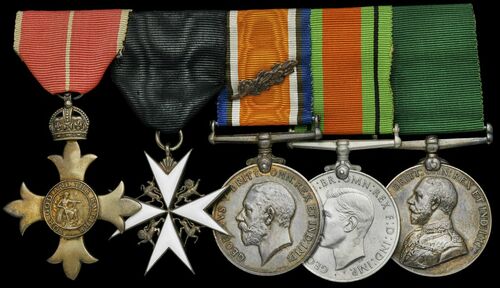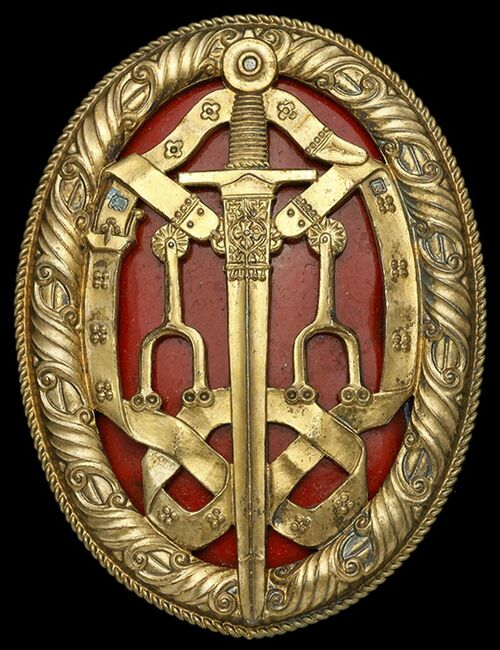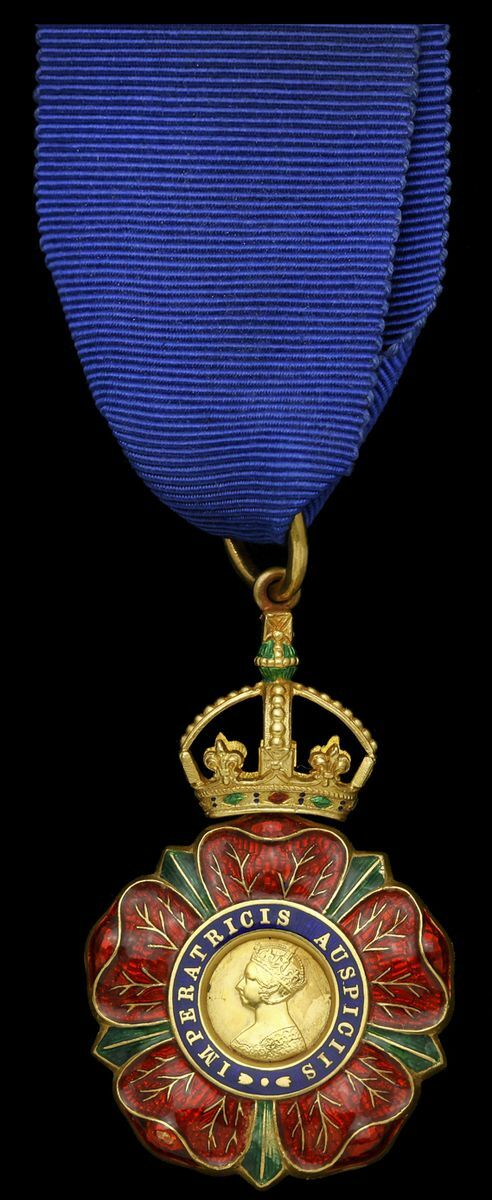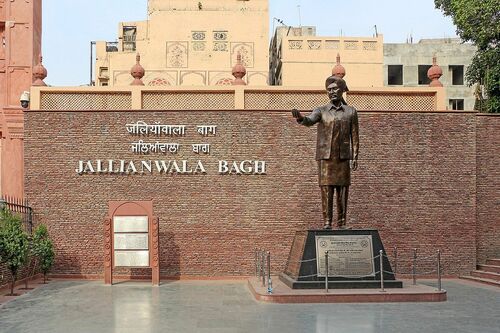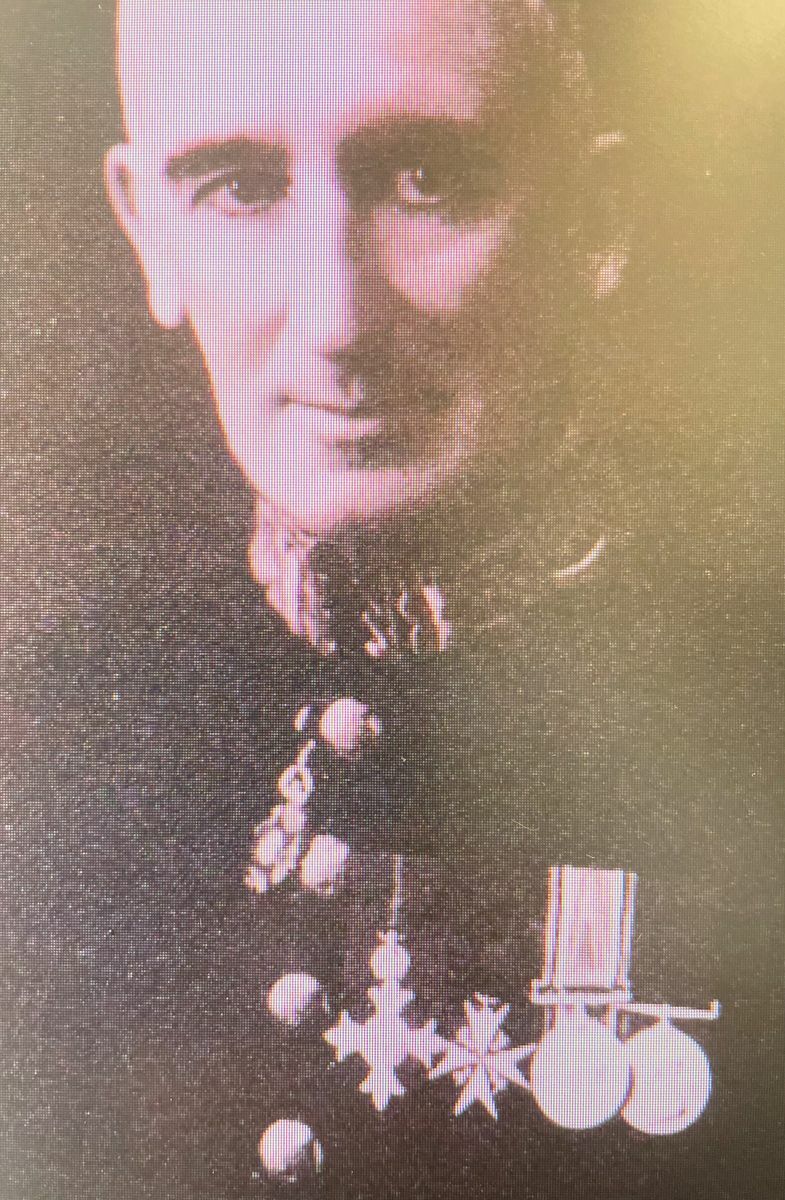Auction: 23002 - Orders, Decorations and Medals
Lot: 98
The Kt., C.I.E., O.B.E., Order of St John group of seven awarded to Lieutenant-Colonel Sir M. Irving, Punjab Rifles and Indian Civil Service
Irving was Deputy Commissioner of Amritsar, the Senior Government Official in charge, who transferred the city's administration to Colonel Dyer in April 1919, which helped to precipitate the Amritsar (Jallianwala Bagh) massacre
Knight Bachelor's Badge, 2nd Type breast Badge, silver-gilt and enamel (Hallmarks for London 1934), in its case of issue; The Most Eminent Order of the Indian Empire, C.I.E., Companion’s 3rd Type neck Badge, gold and enamel; The Most Excellent Order of the British Empire, O.B.E. (Military) Officer’s 1st Type breast Badge, silver-gilt, hallmarks for London 1919, mounted on 2nd Type riband; The Most Venerable Order of St John, breast Badge, silver and enamel; British War Medal 1914-20, with M.I.D. oak leaves (Lt-Col. M. Irving.); Defence Medal 1939-45; Volunteer Force Long Service (India & the Colonies), G.V.R. (Lt. Col. M. Irving. Punjab Rif., A.F.I.), officially impressed naming, mounted as worn where applicable, good very fine (7)
Kt. London Gazette 4 June 1934 (Financial Commissioner, Punjab).
C.I.E. London Gazette 3 July 1926 (Financial Secretary to Government, Punjab).
O.B.E. London Gazette 12 September 1919 (India).
Miles Irving was born on 1 August 1876 at Singapore, Straits Settlements, the son of Charles John Irving, who would become the Auditor-General of Singapore. Educated at Blundell's and Balliol College, Oxford, he sat his Indian Civil Service exams in 1898 and made his way to India in November 1899. Assigned to the Punjab region, by April 1914 he was in Lahore and was made Senior Secretary to the Financial Commissioner, as Assistant Commissioner. With the outbreak of the Great War he was commissioned and rose to become Acting Lieutenant-Colonel from February 1917, initially as Assistant Adjutant-General at Delhi and then at HQ Southern India Command. He earned a 'mention' (London Gazette 26 November 1918, refers) for his British War Medal and an O.B.E. for his laurels by War's end.
Amritsar - key player
After being demobilised, Irving was appointed Deputy Commissioner for Amritsar and the surrounding regions. Muslims of India gave its own review of the events on the centenary of the events that followed:
'By April 6, the anti-Rowlatt satyagraha was at its peak in Punjab. "Practically the whole of Lahore was on the streets," historian Hari Singh has recorded. "The immense crowd that passed through Anarkali was estimated to be around 20,000."
The trial and martyrdom of the Ghadar Party leadership in the Lahore Conspiracy trial, and the internment of some 1,500 of the emigrants in India, proved an abiding symbol for a younger generation of radicals. News of young Muslim who had left to fight for the restoration of the Turkish Caliphate (Tehrek-e-Khilafat) but ended up struggling in the ranks of the Red Army during the defence of Kirke, also trickled in. In Punjab, the doubling of prices of wheat, rice and bajra, and the tripling of salt prices fuelled discontent, particularly among artisans and peasants.
In Amritsar, over 5,000 people gathered at Jallianwala Bagh. By April 9, a new spirit seemed to be in the air. Hindu and Muslim protesters drank water from the same glass. British authority appeared to be collapsing. "The Khan Bahadurs and Rai Sahibs are dead," Amritsar Deputy Commissioner Miles Irving wrote, explaining his lack of control over events, "and are not fresh corpses at that."
On April 10 1919, over 15,000 people gathered at the Carriage Bridge. The enraged crowd, armed with lathis, turned on British officials. Four British residents were killed and two were seriously injured; one, missionary Marcella Sherwood, was left for dead. Government property was burned and looted, with persons from the Katra Kanhaiya red light area and members of the Pherna and Safeda communities ("criminal tribes", in colonial nomenclature) joining the revolt.
When Brigadier General Dyer arrived in Amritsar from Jalandhar at 9 p.m. the next day, his fellow British residents had convinced themselves that the events of 1857 were about to repeat themselves. Irving had called Maqbool Mohammad and asked him to inform the city that it was under military occupation.
In Lahore, the uprising had yet to subside. The Danda Fauj (stick-army) of impoverished Muslim artisans led by Chanan Din marched through the streets with sticks and toy guns, declaring their loyalty to the Amir of Afghanistan and the German Kaiser. Crowds of students proclaimed the death of King George, while rumours were spread that Indian troops had mutinied in the Lahore cantonment.
More dangerously for the Raj, the 4,000 Indian railway employees in Lahore went on strike. Even in rural Kasur, which had earned the wrath of Amritsar and Lahore by failing to join the hartal of April 6, huge demonstrations were held. "This is our last chance," local leader Nadir Ali Shah told the gathering. "We must remove the knife around our throat."
On the morning of April 13, Baisakhi day, Dyer's troops marched through Amritsar, proclaiming that all assemblies would be "dispersed by force of arms if necessary." Shortly afterwards, two people walked through the city banging tin cans to announce a rally at 4:30 p.m. at Jallianwala Baug. By afternoon, a peace gathering of over 20,000 people was in place, hearing a succession of speeches condemning the Rowlatt Act and the recent arrests and firings. (Many of those who had gathered at the maidan, however, were villagers, who were on a visit to Amritsar on the occasion of the Baisakhi fair, and were probably unaware of the morning's drama).
No effort, Dyer later admitted, had been made to prevent the gathering from taking place. An aircraft briefly hovered overhead as five speeches were completed before Dyer arrived at Jallianwala Bagh, along with two young officers, Briggs and Anderson, 50 Indian and British rifle-men, 40 Gurkhas, and two armoured cars.
Dyer was convinced that a major insurrection was at hand. He banned all meetings, and hearing a meeting of 15,000 to 20,000 people had assembled he marched his fifty riflemen to a raised bank and a few minutes before sunset, ordered them to shoot at the crowd which included men, women, and children.
The first of 1,650 rounds were fired into the crowd. Dyer kept the firing up for about ten minutes. Bodies were falling all around and no warning was given to disperse before Dyer opened fire. Many died when they jumped into the well at the left-hand side of the maidan, only to be crushed by others who desperately dived on top of them. The wounded cried for help, but there was no aid at hand.
"I fired and continued to fire until the crowd dispersed," Dyer told the official Lord William Hunter Committee of Inquiry set up to probe the violence, "and I consider this is the least amount of firing which would produce the necessary moral and widespread effect it was my duty to produce, if I was to justify my action."
To this day, no one knows how many died. The Punjab Government first asserted that 291 people were killed. An enquiry by Amritsar Deputy Commissioner F. H. Burton later raised the official toll to 379, and some alleged inaccuracies. It is not impossible that the figure could have been higher, given the turmoil and poor communications of the time. Even, casualty number quoted by different sources was more than 1,500, with approximately 1,000 killed.
Mr. Muhammad Ali Jinnah, with another leading Lawyer, C. R. Das proceeded to Lahore to defend the leaders who were being prosecuted. The Governor of Punjab banned their entry in the province. However, after a year on 13 April 1920 a huge meeting was held in Bombay. Mr. Jinnah presided and said that Dyer was a butcher, and the massacre at Amratsar would move even the stones. The great poet Tigore sent a moving message. Mahatma Gandhi moved the Resolution of condemnation.'
Irving was a central player in the preceding events to the massacre and was solely responsible for the communication to higher powers of the unfolding tensions in the city. On 9 April he was ordered by O'Dwyer to detain Dr Kitchew and Satyapal. His decision to invite them to his residence the next morning and detain them in secret only added fuel to the fire. With the two leaders detained in secret in the Civil Lines, the crowd descended to protest and show their displeasure. It was Irving and Captain Maisie who gave the order to open fire that day which cost 24 lives. With the events beginning to spiral out of control, he transferred the city's administration to Colonel (temp. Brigadier-General) Reginald Dyer, who thence enacted the massacre. Irving was unsurprisingly the first witness called to the Hunter Committee which sat to investigate the events. It remains a stain on Britain to this day and whilst no official apology has ever come from the British Government, David Cameron publicly stated the events were '...a deeply shameful act'. Winston Churchill clearly gave his views in 1920:
'However we may dwell upon the difficulties of General Dyer…one tremendous fact stands out. I mean the slaughter of nearly 400 persons and the wounding of probably three or four times as many….that is an episode which appears to me to be without precedent or parallel in the modern history of the British Empire. It is an event of an entirely different order from any of those tragical occurrences which take place when troops are brought into collision with the civil population. It is an extraordinary event, a monstrous event, an event which stands in singular and sinister isolation.'
Irving remained in India and rose to become Financial Commissioner of the Punjab. He retired with his wife (who earned the Kaisar-i-Hind 1st Class) to Dorset and died at Bridport on 24 June 1962.
Subject to 20% VAT on Buyer’s Premium. For more information please view Terms and Conditions for Buyers.
Sold for
£2,900
Starting price
£1900

